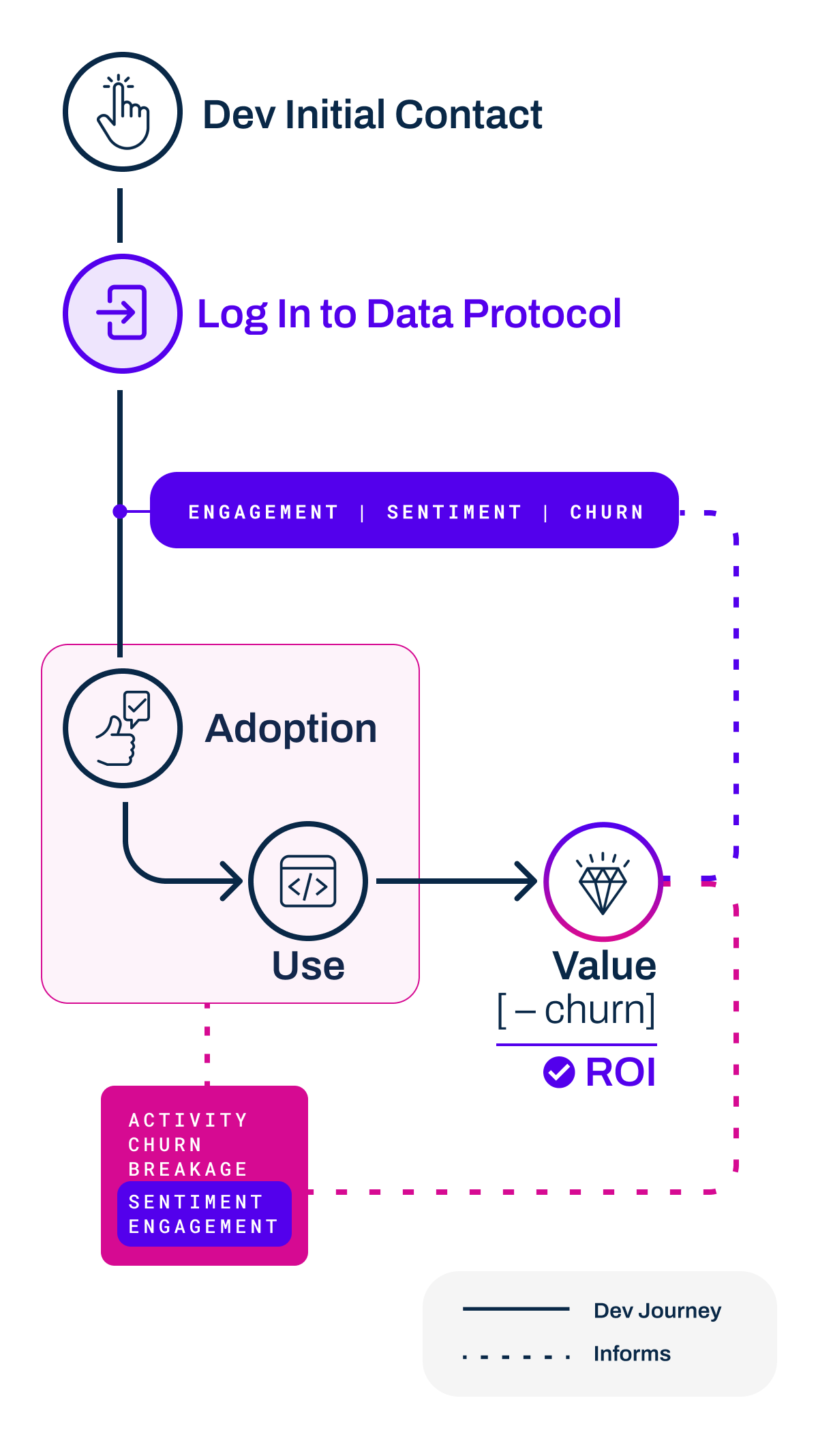Measuring Developer Engagement - a playbook
Measure What Matters: Unlock Developer Success
Introduction
Every developer-first company benefits from having clear metrics about their developers. You need to measure developer engagement, activity, and value. You need to know who is interested in your products, and why. Whether you're driving adoption for a new product, building your developer network from the ground up, or supporting an existing community of users, you can't manage what you can't measure.

Check-in
Answer the check-in questions throughout the playbook to find out how your onboarding program ranks, and how you could improve.
Give your developers the support they need. Data Protocol's dynamic video content and interactive resources improve engagement, sentiment, and value. Low-friction account creation for every developer means you will finally have attributable metrics throughout the developer lifecycle. With Data Protocol you can unlock the data you need to inform and improve your products, your process, and your program. This is our playbook.
Data Protocol Unlocks Value
Integrate Data Protocol into your onboarding process to measure pre-adoption activity and access data you've always wanted and never had.
What is the actual LTV of your developers?

Step 01: Know Your Audience
The first step to unlocking your metrics is attribution. Most programs are able to attribute activity and even engagement with their developers post adoption. These metrics are important and foundational to understanding how your product is being used and the support your developers need to be successful. However, they can only tell part of the story.
To optimize your metrics, you need your developers to register sooner, even before adoption, and log in more often. You cannot put standard developer documents and blog posts behind a registration wall and expect developers to appreciate that barrier. Rather, you need a process that exchanges real value for attribution. A one-click SSO, with more engaging content and resources on the other side, creates a low-friction way of gathering data.
There are two keys to building a successful attribution funnel:
- The first is the Clarity of Value. Whether delivered during onboarding or incorporated into documentation, the promise of a better, faster, more efficient way of receiving support should be clear. Create engaging, actionable content that solves critical challenges throughout the developer's journey.

- The second key is the Ease of Use. Lowering the point of friction to a single click removes barriers to entry, while reinforcing that there is enough value on the other side of the click to warrant it in the first place.

Check-in
1/3
Ask yourself:
At what point in your onboarding funnel do your developers sign up / register / log in?
What data are you missing from your network today?
Step 02: Measure Everything
Any data that helps you better reach, convert, and support your developers is valuable. The challenge is that you don't know which metrics will matter until you start measuring them. Gathering data to form insights begins with knowing what you can measure and how.
Check-in
2/3
Check each metric you're currently monitoring:
If you left any unchecked, is it because they are:
Step 03: Follow the Data
With the right data in hand you can draw insights about your product, process, and program. The byproduct of measuring everything will be immediate: lots of data. The value may take more time to realize.
Use early data to build a framework and continue to iterate on what you measure, when you measure, and most importantly why you are measuring. Follow the data where it leads, but don't be afraid to challenge the findings or even change the process. Good data, thoughtfully applied to a well-defined problem, is a powerful tool for any developer-first company.

Check-in
3/3
Which of the following metrics do you rely on when making product decisions:
Step 04: Inform and Improve
Now that you can measure these key indicators, you can manage them. Track the impact of your programs month-over-month and outline actionable steps for improvement. The insights you derive from attributable data should be used to:
- Flag indicators of churn and breakage
- Identify signals of growth and value
- Monitor your network and predict risk
- Evaluate your products and invest in the right innovation
- Improve your processes to eliminate challenges and inefficiencies

By following this playbook, you can effectively integrate attributable metrics into your developer management and support programs. Make informed decisions, drive performance improvements, and foster a thriving developer community that contributes to your organization's overall success.
The Data Protocol Approach
Data Protocol is a developer engagement and support platform. We help developer-first companies produce dynamic content with attributable metrics that are fundamental to program success.
Your Results:
Answer the check-in questions throughout the playbook to see how your onboarding program is performing, and how you can improve.
Here's how we help you:
01. Know Your Audience:Data Protocol creates an attribution funnel. Whether during onboarding or post adoption, the attribution enables better metrics as developers frequently log in throughout your program.
02. Measure Everything:For the first time, you can measure churn (pre and post adoption), engagement throughout the funnel, sentiment at every step, activity, and ultimately determine a more accurate value and ROI.
03. Follow the Data:The data you gather is going to supercharge your content, inform outreach, and improve engagement over time for a more effective (and valuable) developer program.
04. Inform and Improve:As a partner, we help you improve your products, monitor your metrics, and deliver the insights you need to increase the LTV of your developers.
Content and resources without an understanding of individual and aggregate needs can only tell part of the story. Let's talk about how to unlock the data you need.
Let's Talk
